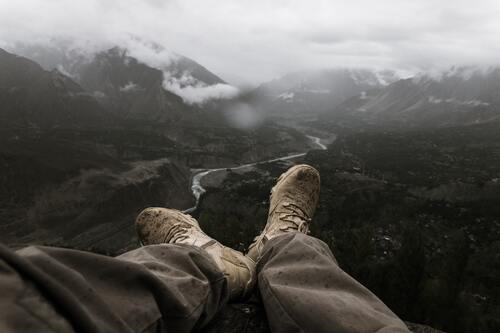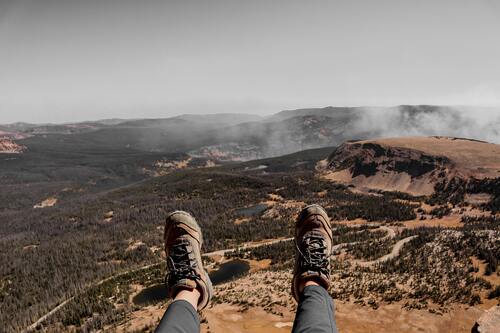Avid hikers know all about the many beauties of hiking. The scenery, the flowers, the birds, all the sounds and smells, the sunrises and sunsets. Hiking is a great experience all around, but it can cause you to experience painful and sore knees.
A hiker’s knee is a condition that causes serious knee problems, especially after walking or hiking. Many hikers will experience hiker’s knee at least once in their lifetime. Having bad knees and joint pain is never good, so I want to tell you more about how to prevent it.
This guide will discuss the knee pain that comes from hiking and the best ways to protect your knees while hiking uphill or downhill. You can also learn more about the recovery period and the best recovery methods towards the end of the guide. So, read the guide to learn more about the topic!
More...

Table of Contents
Why Does Hiking Hurt My Knees?
There can be several reasons you experience knee pain during or after a hike. It could be regular soreness from the hike that will go away in a couple of days, but it could also be a more serious injury.
So, you have to think long and hard about the happenings during the hike that could have contributed to or caused your knee pain. Let’s talk about the soreness and injuries some more to help you determine if you are experiencing one or the other:
Knee Injury
If you are experiencing severe knee pain for days or weeks after the hike, chances are you are dealing with a more severe injury. Knee injuries can happen if you put severe strain on your knees while hiking, climbing, jumping onto something, making larger steps than usual, and so on. They can also happen if you slip, fall, or bump your knees while hiking.
Such serious injuries might also cause bruising, swelling around the knee, and pain in the surrounding cartilage. If you see that the pain is persistent and worsening, the best thing would be to visit a doctor or physical therapist as soon as possible.
Knee soreness
You can experience sore muscles and knees while hiking, especially if you are not in the best shape. If you are not someone who hikes often, it will take time for you to build muscle memory and for your knee to get used to the strain.
Another reason why you could be experiencing knee soreness is due to improper gear but, most of all, improper footwear. Suppose you plan to take anything more than occasional short hikes. In that case, you will need to invest in quality hiking boots with good traction, extra support, and superb comfort. Having proper hiking boots can even help improve stability when walking on challenging terrain.
It would help if you were mindful of your backpack and the weight you carry. Carrying a heavier load could cause knee soreness too. To have a pain-free hike, your pack and all its straps must be properly adjusted, with the weight balanced on both sides.
So, as you can see, many things can cause you to get a hiker's knee. The best thing is to know all about these things before you start hiking so you know how to protect your knees.

How to Prevent Knee Pain When Hiking?
You need to know how the knee works to prevent injury and protect your knees from the pain. Knee joints are the most movable part of your body, and your entire body weight rests on them. Understandably, even the slightest knee injury should be taken seriously.
So, it would be best to know the most effective ways to protect your knees and prevent pain when hiking both up and downhill. Let’s talk about that some more:
How to Prevent Knee Pain from Hiking Downhill?
Hiking downhill puts a severe strain on your knees. Your knees need to work three or four times more when hiking downhill than walking on level terrain. This means there is a higher chance of injury.
When walking downhill, one of the things to remember is that you should not be rushing. Keep a steady, slow, comfortable pace. Do not lock out the knees – have your knees slightly bent at all times. It could also help you walk in zigzag lines and not straight down.
Try walking on softer terrain like grass instead of rugged, uneven terrain. Keep your pack weight as low as possible, meaning disposing of excess water and eating most of your food before descending. You need to redistribute weight in your backpack and keep it balanced.
Investing in comfortable hiking boots with ankle and arch support and comfortable soles with excellent traction would be best. Your entire gear needs to be comfortable and protective, but hiking boots are most important if you want to reduce pain in your legs and knees.
Wearing knee braces, knee sleeves, ankle braces, or using hiking poles can also prove helpful. So, keep that in mind whenever preparing for a hike.
How to Prevent Knee Pain from Hiking Uphill?
Hiking uphill is also quite dangerous for your knees, although you are not as likely to get your knees hurt as you are during downhill hiking.
To protect your knees when hiking uphill, you must take short steps and hike at a controlled pace. Then, make sure you make each step with your entire foot instead of stepping only on your toes.
When walking, your upper body needs to be upright, with the torso right above your hips. Keep your knee and shin vertical to the ground.
The things I mentioned in the previous section regarding weight distribution and gear apply here. So, ensure you have proper quality gear, trek poles, and a nicely-fitted backpack that does not weigh too much.

How to Recover My Knees after Hiking?
Allowing your knees and entire body to recover after a hike is almost as important as keeping your body safe during the hike. With the proper recovery method and enough recovery time, you will successfully reduce knee pain without medication or a doctor.
So, once you finish a hike and get home, here are some of the things you should consider doing:
Recovery Method
After hikes, I recommend eating more fruits and vegetables, nuts or spices, drinking lots of water and green tea, and using dark chocolate as your dessert. Try using more olive oil when cooking since it can help your recovery.
It would be wise to consume more lubricating, anti-inflammatory foods like, for example, fatty fish. Such fish have a ton of Omega-3 acids, which are great for bones, muscles, and maintaining an overall healthy body.
That is all about the diet – let’s move on to the rest. After your hike:
- Allow your body to rest.
- Keep your legs elevated, especially the part below the knees.
- Do regular stretches throughout the day while also massaging your legs whenever you need.
Another thing that I have found to be helpful is doing cold or warm compressions. I usually go for cold compressions with ice cubes, which are very helpful for sore joints. If you do not like this idea, you can always go with something else – high compression socks, a knee sleeve, a knee brace that leaves your kneecap exposed, and so on.

Recovery Time
If you are experiencing any pain or soreness after a hike, it could be a good idea to take it easy for at least a few days before returning to the trail. The same goes for hikers who do not experience any pain or injuries. Allowing your body to rest and recover for a few days is crucial to avoid future injuries.
The ideal recovery time is between three and five days, depending on your shape, experience, and soreness. If you have been hiking for a while, returning to working out or hiking within a few days could be okay.
If you are new to hiking, you should avoid putting more stress on your body for a while. Listen to your body and what it tells you – you will know whenever it is ready to get back on the trail.
Pain Medication
Finally, many hikers consider taking pain relief medications to help with the pain. I would advise against taking any medication unless told otherwise by a doctor. If the pain is persistent and unbearable, visit a doctor as soon as possible.
Wrap-Up
I hope this guide taught you a lot about what could be causing pain in your knee joints, as well as all the things you can do as an after-hike recovery. A hiker’s knee is a severe condition, so you should do your best to prevent it and keep your knees safe.
If you know any other helpful tips or tricks for preventing knee pain, feel free to share them in the comments below. They could prove beneficial for hikers still trying to learn the best practices for reducing knee pain.
- Are Merrell Shoes Good? – An Unbiased Review of Merrell Footwear - December 9, 2023
- Where Are Merrell Shoes Made? - December 9, 2023
- Camping in 40-degree Weather: Tips and Tricks - September 25, 2023

![How to Protect Yourself While Camping? [TOP Camping Safety Tips] How to Protect Yourself While Camping? [TOP Camping Safety Tips]](https://grandcircletrails.com/wp-content/uploads/2022/07/How-to-Protect-Yourself-While-Camping-1-150x150.jpg)

![3 Ways to Hang a Hammock in Your Apartment [Must-Read] 3 Ways to Hang a Hammock in Your Apartment [Must-Read]](https://grandcircletrails.com/wp-content/uploads/2021/09/Can-You-Hang-a-Hammock-in-an-Apartment-1-150x150.jpg)
![How to Get Campfire Smell Out of Clothes? [Proven Ways] How to Get Campfire Smell Out of Clothes? [Proven Ways]](https://grandcircletrails.com/wp-content/uploads/2021/11/How-to-Get-Campfire-Smell-Out-of-Clothes-1-150x150.jpg)
![How to Get Smell Out Of Yeti Cooler? [Ways To Remove Odors] How to Get Smell Out Of Yeti Cooler? [Ways To Remove Odors]](https://grandcircletrails.com/wp-content/uploads/2022/02/How-to-Get-Smell-Out-Of-Yeti-Cooler-1-150x150.jpg)
![Why Does a Campfire Pop? [7 Ways To Prevent It] Why Does a Campfire Pop? [7 Ways To Prevent It]](https://grandcircletrails.com/wp-content/uploads/2022/05/Why-Does-a-Campfire-Pop-150x150.jpg)